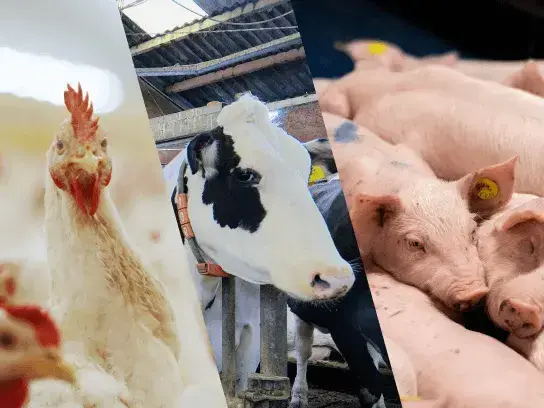Light is a fundamental aspect of life, influencing the daily routines and overall well-being of animals. In this comprehensive guide, we explore seven key ways light cycles enhance animal health and boost livestock productivity. Understanding these elements can significantly improve animal health and farm efficiency.
1. Regulating Sleep Patterns
Light cycles play a critical role in regulating sleep patterns. Diurnal animals, which are active during the day, rely on light cues to determine when to wake up and sleep, while nocturnal animals have the opposite pattern. Disrupting these cycles can lead to stress and health issues. Proper management of light cycles can ensure animals get the rest they need, promoting overall well-being.

2. Influencing Feeding Habits
Light exposure also affects feeding habits. Many animals, including livestock, prefer to eat during daylight hours. Consistent light schedules help maintain regular feeding times, crucial for growth and productivity. Ensuring that animals have a stable light environment can lead to better feed conversion rates and overall healthier animals.
Ensuring barn air stays out of lighting fixtures is key, as the fumes commonly found in barn environments can quickly harm the internal electronics and LEDs. This is especially vital in areas where animals spend most of their time. To safeguard against these conditions, IP67 fixtures are highly recommended. These fixtures are designed to be completely sealed, preventing any air from seeping in and causing damage. While they are also built to withstand being temporarily submerged in water, this is a scenario that seldom happens.
3. Hormonal Regulation
Light impacts various physiological processes, including hormone production. Light exposure influences the production of hormones such as melatonin, which regulates sleep and is produced in the dark. Proper light management helps in maintaining the balance of hormones, aiding in better sleep and activity patterns for the animals.
4. Enhancing Reproductive Cycles
Light is a key factor in regulating reproductive cycles. Many animals breed seasonally, with light acting as a signal for mating periods. Proper light management can enhance breeding success and improve reproductive efficiency. By simulating natural light cycles, farmers can increase fertility rates and achieve better breeding outcomes.

5. Optimizing Growth and Productivity
Consistent light exposure promotes better growth and productivity. Animals with regular light schedules tend to grow faster and convert feed more efficiently. Optimizing light exposure can significantly boost livestock productivity, leading to increased yields and healthier animals.
6. Reducing Stress and Enhancing Comfort
Proper light management is crucial for animal welfare. Consistent light cycles reduce stress by promoting regular sleep and feeding patterns, essential for reducing anxiety. Adequate lighting in housing areas helps animals navigate safely, reducing the risk of injuries and enhancing overall comfort.
7. Practical Light Management Strategies
Implementing effective light management strategies is essential for optimizing animal health and productivity. Here are some practical tips:
- Maintain Consistent Schedules: Keep light schedules consistent to avoid disrupting biological rhythms. Gradually adjust light cycles if necessary to minimize stress.
- Adjust for Seasonal Changes: During shorter winter days, extend artificial light exposure to maintain consistent cycles. In summer, reduce artificial light to match longer daylight hours.
- Monitor Light Intensity: Ensure the intensity of light is appropriate. Both too much and too little light can be harmful. Use timers and dimmers to control light levels and ensure animals receive optimal exposure.

Specific Light Management for Different Types of Livestock
Different types of livestock have unique light requirements. Understanding these needs can help optimize care and productivity.
- Poultry: Poultry, such as chickens, require specific light cycles for egg production. A consistent schedule of 14-16 hours of light per day can maximize egg laying. Adjusting light exposure can also help manage molting and other seasonal changes.
- Cattle: Cattle benefit from extended light periods. Research shows dairy cows exposed to 16-18 hours of light per day produce more milk. Beef cattle also grow faster with extended light exposure.
- Swine: Pigs need balanced light exposure for optimal growth and reproduction. Sows exposed to consistent light cycles have higher fertility rates and better overall health.
Light cycles play a vital role in animal health, behavior, and productivity. By understanding and optimizing light exposure, farmers can enhance livestock performance, improve reproductive success, and ensure overall well-being. Proper light management is crucial for successful and sustainable animal husbandry. Maintaining consistent schedules, monitoring light intensity, and adjusting for seasonal changes can help farmers harness the power of light to boost livestock productivity and welfare.
Stay informed
Lighting matters. That's why we share our knowledge with the world through HATO Insights.
Cattle
How RUDAX LED Systems Deliver Measurable Supply Chain Gains
As global demand for dairy continues to rise, milk processors are under pressure to ensure consistent, high-volume, and high-quality milk supply. On-farm...
Cattle
Case Study: Validating the Impact of RUDAX Lighting on Dairy Cow Milk Production
Precision Lighting Shows Measurable Gains in Yield and Quality of Milk Lighting remains one of the most overlooked yet high-impact levers in dairy production....
At HATO, we think high-quality lighting solutions, designed to enhance animal welfare and livestock production, must be accessible and affordable for all farmers.
Success Stories
Five Years, Zero Replacements: Why CORAX Is George Navaro’s Lighting of Choice
Herman Kusters: I would definitely recommend RUDAX

.webp)
.webp)